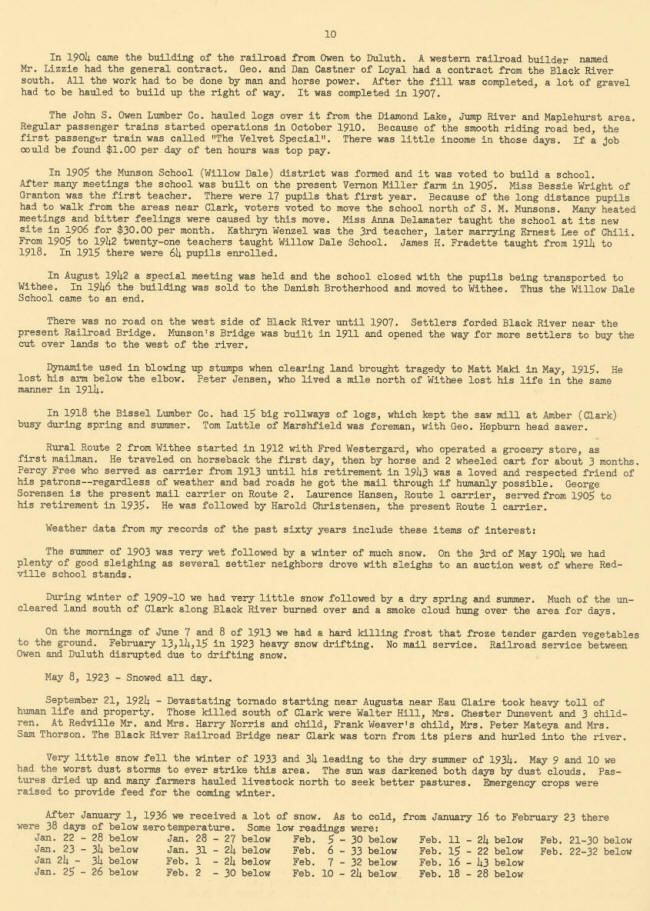|
[Memory
Trails Index]
Transcription
Janet Schwarze
In 1904 came the building of the
railroad from Owen to Duluth. A western railroad builder named Mr. Lizzie had
the general contract. Geo. and Dan Castner of Loyal had a contract from the
Black River south. All the work had to be done by man and horse power. After the
fill was completed, a lot of gravel had to be hauled to build up the right of
way. It was completed in 1907.
The John S. Owen Lumber Co. hauled logs over it from the Diamond Lake, Jump
River and Maplehurst area. Regular passenger trains started operations in
October 1910. Because of the smooth riding road bed, the first passenger train
was called “The Velvet Special”. There was little income in those days. If a job
could be found $1.00 per day of ten hours was top pay.
In 1905 the Munson School (Willow Dale) district was formed and it was voted to
build a school. After many meetings the school was built on the present Vernon
Miller farm in 1905. Miss Bessie Wright of Granton was the first teacher. There
were 17 pupils that first year. Because of the long distance pupils had to
walk from the areas near Clark, voters voted to move the school north of S. M.
Munsons. Many heated meetings and bitter feelings were caused by this move. Miss
Anna Delamater taught the school at its new site in 1906 for $30.00 per month.
Kathryn Wenzel was the 3rd teacher, later marrying Ernest Lee of Chili. From
1905 to 19142 twenty—one teachers taught Willow Dale School. James H. Fradette
taught from 19114 to 1918. In 1915 there were 6k pupils enrolled.
In August 19142 a special meeting was held and the school closed with the pupils
being transported to Withee. In 19146 the building was sold to the Danish
Brotherhood and moved to Withee. Thus the Willow Dale School came to an end.
There was no road on the west side of Black River until 1907. Settlers forded
Black River near the present Railroad Bridge. Munson’s Bridge was built in 1911
and opened the way for more settlers to buy the cut over lands to the west of
the river.
Dynamite used in blowing up stumps when clearing land brought tragedy to Matt
Maid in May, 1915. He lost his arm below the elbow. Peter Jensen, who lived a
mile north of Withee lost his life in the same manner in 1914.
In 1918 the Bissel Lumber Co. had 15 big rollways of logs, which kept the saw
mill at Amber (Clark) busy during spring and sunnier. Tom Luttle of Marshfield
was foreman, with Geo. Hepburn head sawyer.
Rural Route 2 from Withee started in 1912 with Fred Westergard, who operated a
grocery store, as first mailman. He traveled on horseback the first day, then by
horse and 2 wheeled cart for about 3 months. Percy Free who served as carrier
from 1913 until his retirement in 19143 was a loved and respected friend of his
patrons--regardless of weather and bad roads he got the mail through if humanly
possible. George Sorensen is the present mail carrier on Route 2. Laurence
Hansen, Route 1 carrier, served from 1905 to his retirement in 1935. He was
followed by Harold Christensen, the present Route 1 carrier.
Weather data from my records of the past sixty years include these items of
interest:
The summer of 1903 was very wet followed by a winter of much snow. On the 3rd of
May 190k we had plenty of good sleighing as several settler neighbors drove with
sleighs to an auction west of where Redville school stands.
During winter of 1909-10 we had very little snow followed by a dry spring and
summer. Much of the uncleared land south of Clark along Black River burned over
and a smoke cloud hung over the area for days.
On the mornings of June 7 and 8 of 1913 we had a hard killing frost that froze
tender garden vegetables to the ground. February 13,114,15 in 1923 heavy snow
drifting. No mail service. Railroad service between Owen and Duluth disrupted
due to drifting snow.
May 8, 1923 - Snowed all day.
September 21, 1924 — Devastating tornado starting near Augusta near Eau Claire
took heavy toil of human life and property. Those killed south of Clark were
Walter Hill, Mrs. Chester Dunevent and 3 children. At Redville Mr. and Mrs.
Harry Norris and child, Frank Weaver’s child, Mrs. Peter Mateya and Mrs. Sam
Thorson. The Black River Railroad Bridge near Clark was torn from its piers and
hurled into the river.
Very little snow fell the winter of 1933 and 314 leading to the dry summer of
193k. May 9 and 10 we had the worst dust storms to ever strike this area. The
sun was darkened both days by dust clouds. Pastures dried up and many farmers
hauled livestock north to seek better pastures. Emergency crops were raised to
provide feed for the coming winter.
After January 1, 1936 we received a lot of snow. As to cold, from January 16 to
February 23 there were 38 days of below zero temperature. Some low readings
were:
|
Jan. 22 - 28 below
Jan. 23 - 314 below
Jan 24 - 34 below
Jan. 25 - 26 below
Jan. 28 - 27 below
Jan. 31 - 24 below
Feb. 1 - 24 below
Feb. 2 - 30 below
Feb. 5 -30 below |
Feb. 6 - 33 below
Feb. 7 - 32 below
Feb. 10 - 24 below
Feb. 11 - 24 below
Feb. 15 - 22 below
Feb. 16 - 43 below
Feb. 18 - 28 below
Feb. 21-30 below
Feb. 22-32 below |
[Next]
[Memory
Trails Index]
|
